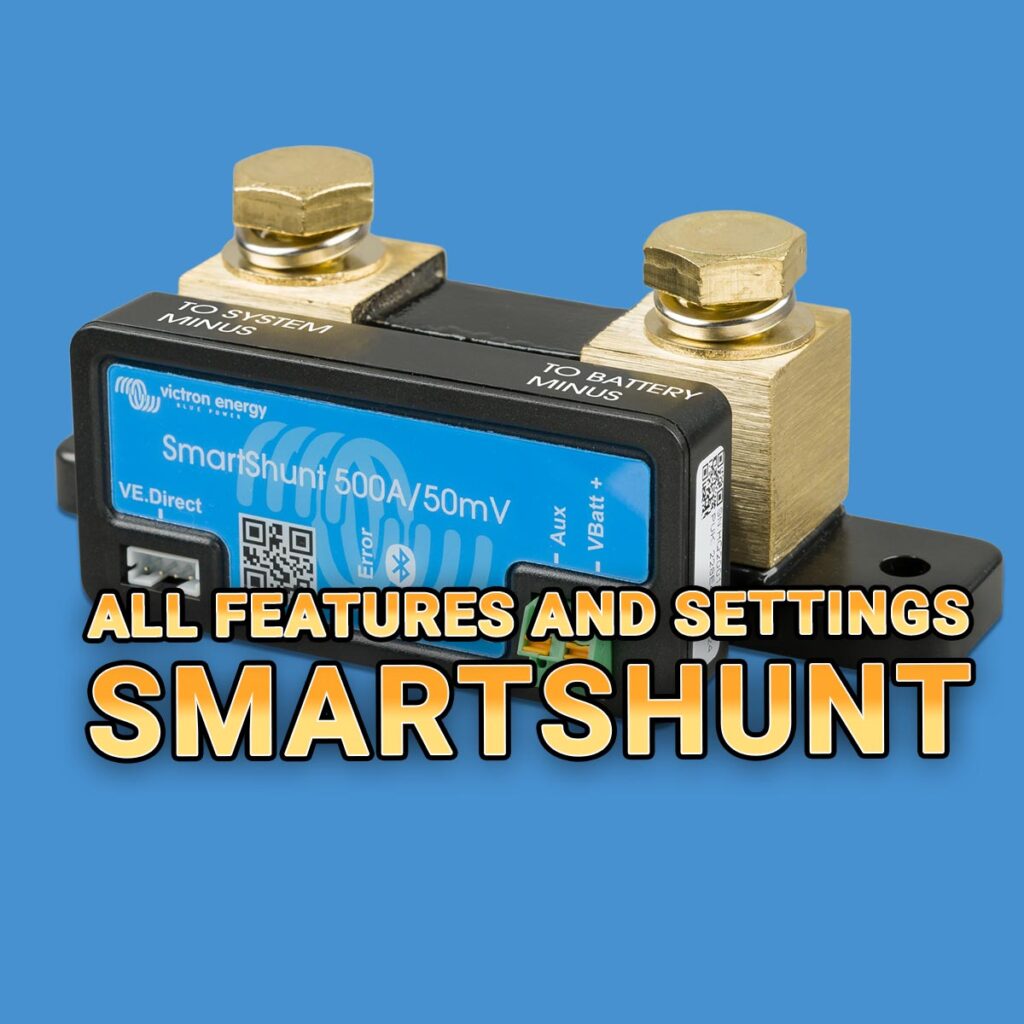How to Operate and Use the Victron SmartShunt

Now that you know what the Victron Smartshunt does, how to install it and and how to change its settings, let’s now take a look at how to Operate and Use the Victron SmartShunt.
This tutorial delves into the intricacies of the Victron SmartShunt’s operation. We’ll start by exploring how the battery monitor works, including its ability to measure current flow and calculate the state of charge. You’ll learn how to interpret the various readouts available on the VictronConnect app, such as state of charge, battery voltage, and power, among others.
I’ll also guide you through the LED status codes and what they signify about your device’s operational and connection states. For those interested in data, I’ll cover how to access historical data through the VictronConnect app, and how this data can be useful for evaluating your battery’s health and usage patterns.
Additionally, you’ll find out how to set up alarms for different conditions like low battery state of charge or high battery voltage.
Finally, I’ll touch on the topic of synchronizing your battery monitor to ensure accurate readouts, and how the SmartShunt can also function as a DC energy meter.
How Does the Battery Monitor Work?
The primary role of the Victron SmartShunt ($95.95) battery monitor is to track and display the state of charge (SoC) of a battery.
This is crucial for understanding how much charge is left in the battery and for preventing unexpected total discharges.
Continuous Measurement
The battery monitor continuously measures the current flowing into and out of the battery.
By integrating this current over time, the monitor calculates the net amount of ampere-hours (Ah) added to or removed from the battery.
For instance, if there is a discharge current of 10A for 2 hours, the battery will lose 10 x 2 = 20Ah.
Accounting for Variables
However, the actual capacity of a battery is influenced by several factors:
- Rate of Discharge: The effective capacity of a battery varies depending on how quickly it is being discharged.
- Peukert Efficiency: This is a measure of how well the battery performs under different rates of discharge.
- Temperature: The battery’s performance can also be affected, albeit to a lesser extent, by its temperature.
Charge Efficiency
Another complexity arises when charging the battery. More energy (in Ah) needs to be input into the battery during charging than can be retrieved during the next discharge cycle. This means the charge efficiency is less than 100%.
The Victron SmartShunt ($95.95) battery monitor takes all these factors into account when calculating the state of charge, providing a more accurate and comprehensive understanding of your battery’s health and remaining capacity.
Readout Overview
In the VictronConnect app, the battery monitor status screen provides a comprehensive overview of key parameters related to your battery’s health and performance.
These include:
- State of Charge (SoC)
- Battery Voltage
- Battery Current
- Power
- Aux Input Reading
- Starter Battery
- Midpoint
- Temperature
State of Charge (SoC)
This is the actual percentage of charge remaining in the battery, adjusted for both Peukert efficiency and charge efficiency.
A fully charged battery will display a SoC of 100.0%, while a fully discharged battery will show 0.0%.
If the SoC shows three dashes “—“, it means the battery monitor is in an unsynchronized state.
This usually happens when the monitor has just been installed or has been left unpowered and is powered up again.
For more information, see the Synchronizing the battery monitor [17] chapter.
Battery Voltage
This parameter shows the terminal voltage of the battery.
Battery Current
This is the real-time current flowing into or out of the battery. A negative value indicates that current is being drawn from the battery, which is used for DC loads.
A positive value means that current is flowing into the battery, typically from charging sources. It’s important to note that the monitor will always display the net battery current, which is the current going into the battery minus the current coming out.
Power
This shows the power being either drawn from or received by the battery.
Consumed Ah (Ampere-Hours)
The Victron SmartShunt ($95.95) battery monitor keeps a record of the Ampere-hours (Ah) that have been removed from the battery, adjusted for efficiency.
- Example: If a current of 12A is drawn from a fully charged battery for 3 hours, the “Consumed Ah” readout will display -36.0Ah (-12 x 3 = -36).
Note: If the “Consumed Ah” readout shows three dashes “—“, it indicates that the battery monitor is in an unsynchronized state.
This usually occurs when the monitor has just been installed or has been left unpowered and is powered up again.
Time Remaining
The battery monitor estimates the remaining time the battery can sustain the current load.
This is known as the “time-to-go” readout. It calculates the time left until the battery is discharged to the set “discharge floor,” which is by default set at 50%.
Caution: If the load on the battery is fluctuating heavily, the “time-to-go” readout may not be reliable. It should be used as a guideline only. For more accurate monitoring, it’s recommended to rely on the state of charge readout.
Input (Auxiliary Input State)
The state of the auxiliary input will depend on how you’ve configured the battery monitor.
You’ll see one of the following options:
- Starter Battery Voltage: Displays the voltage of a second battery if you’ve set up the auxiliary input for this purpose.
- Battery Temperature: Shows the temperature of the main battery when an optional temperature sensor is used.
- Midpoint Voltage Deviation: Indicates the percentage deviation between the voltage of the top and bottom sections of the main battery bank.
By understanding and regularly checking these additional parameters, you can gain a more comprehensive view of your battery’s status and performance, allowing for better management and potentially extending its lifespan.
LED Status Codes
The Victron SmartShunt ($95.95) battery monitor comes with two LEDs that are associated with its Bluetooth interface. Understanding these LED status codes can help you quickly diagnose the operational and connection state of the device.
On Power-Up
- Blue LED: Will blink
- Red LED: Will quickly flash, followed by a short flash to confirm its functionality
Bluetooth Connection
- Blue LED Blinking: Indicates that the Bluetooth interface is ready to connect to the VictronConnect app.
- Blue LED On: Indicates a successful Bluetooth connection to the VictronConnect app.
By understanding these LED status codes, you can quickly assess the operational and connection state of your SmartShunt battery monitor, making troubleshooting and regular operation more straightforward.
Trends and Data Logging
The VictronConnect app offers a robust data logging feature for the SmartShunt battery monitor.
Provided that the firmware of the battery monitor is up-to-date, the app will store up to 45 days of historical data.
This allows for in-depth analysis and trend identification over time, which can be invaluable for battery management and maintenance.
Parameters Tracked
You can view two of the following parameters side-by-side for a comprehensive understanding of your battery’s performance:
- Voltage (V): Monitors the terminal voltage of the battery.
- Current (A): Tracks the real-time current flowing in or out of the battery.
- Power (W): Measures the power being either drawn from or received by the battery.
- Consumed Amp Hours (Ah): Keeps a record of the Ampere-hours removed from the battery.
- State of Charge (%): Provides the actual percentage of charge remaining in the battery.
- Temperature (°C): Monitors the temperature of the battery, provided an optional temperature sensor is used.
By utilizing this data logging feature, you can gain insights into the long-term performance and health of your battery, making it easier to take proactive steps for its care and maintenance.
History and Historical Data
The SmartShunt battery monitor also features a history function that stores past events related to battery usage and health.
This historical data can be invaluable for evaluating usage patterns, identifying trends, and assessing the overall health of your battery over time.
Data Storage
The historical data is stored in a non-volatile memory, ensuring that it remains intact even if the power supply to the battery monitor is interrupted or if the monitor is reset to its default settings.
Accessing Historical Data using Victron Connect App
To access this historical data follow these easy steps:
- Open the VictronConnect app on your device.
- Navigate to the “History” tab within the app.
Here, you can review past events and data points, providing a comprehensive view of your battery’s performance and condition over time.
This feature is particularly useful for long-term battery management and can help you make informed decisions about maintenance and potential replacements.
Types of Historical Data Stored
The SmartShunt battery monitor keeps a detailed record of various types of historical data, offering a comprehensive view of your battery’s performance and health over time.
Here’s a breakdown of the types of data stored:
- Discharge Information in Ah
- Energy in kWh
- Charge Information
- Battery Voltage
- Voltage Alarms
Discharge Information in Ah (Ampere-Hours)
- Deepest Discharge: Records the deepest discharge the battery has undergone. Each time the battery is discharged deeper, the old value is overwritten.
- Last Discharge: Tracks the Ah consumed during the current cycle since the last synchronization.
- Average Discharge: Calculates the average discharge by dividing the cumulative Ah drawn by the total number of cycles.
- Cumulative Ah Drawn: Records the total number of Ampere-hours drawn from the battery over its lifetime.
Energy in kWh (Kilowatt-Hours)
- Discharged Energy: The total amount of energy drawn from the battery, measured in kWh.
- Charged Energy: The total amount of energy absorbed by the battery, measured in kWh.
Charge Information
- Total Charge Cycles: Counts the number of charge cycles over the lifetime of the battery monitor. A cycle is counted each time the state of charge drops below 65% and then rises above 90%.
- Time Since Last Full Charge: Records the number of days since the battery was last fully charged.
- Synchronizations: Counts the number of automatic synchronizations.
- Number of Full Discharges: Records the number of times the battery has been fully discharged to a state of charge of 0%.
Battery Voltage
- Min Battery Voltage: Records the lowest battery voltage.
- Max Battery Voltage: Records the highest battery voltage.
- Min Starter Voltage: Records the lowest auxiliary battery voltage, if applicable.
- Max Starter Voltage: Records the highest auxiliary battery voltage, if applicable.
Voltage Alarms
- Low Voltage Alarms: Counts the number of low voltage alarms.
- High Voltage Alarms: Counts the number of high voltage alarms.
By regularly reviewing this historical data in the VictronConnect app, you can gain valuable insights into your battery’s performance, which can guide you in its maintenance and care.
Alarms and Notifications
The SmartShunt battery monitor is equipped with a software-based alarm system that can trigger alarms for a variety of conditions, enhancing the safety and management of your battery system.
Types of Alarms
The monitor can raise alarms for the following situations:
- Low Battery State of Charge (SOC): Triggered when the battery’s state of charge falls below a set threshold.
- Low Battery Voltage: Activated when the battery voltage drops below a certain level.
- High Battery Voltage: Triggered when the battery voltage exceeds a set limit.
- Low and High Starter Battery Voltage: Activated if the AUX input is set to “Starter battery” and the voltage falls outside of set parameters.
- Midpoint Voltage: Triggered if the AUX input is set to “Midpoint” and the midpoint voltage falls outside of set parameters.
- High and Low Battery Temperature: Activated if the AUX input is set to “Temperature” and the temperature falls outside of set parameters.
Alarm Settings
The thresholds for these alarms are configurable, allowing you to tailor the system to your specific needs.
For more details on how to set these thresholds, refer to the Alarm Settings chapter in the manual.
Alarm Notifications
When an alarm is triggered:
- Via VictronConnect App: The alarm will be displayed within the app. The alarm is acknowledged when a button within the app is pressed.
- Via GX Device: If the battery monitor is connected to a GX device, the alarm will be displayed on the GX device’s screen or the VRM portal. The alarm is acknowledged when viewed in notifications.
Important Note
Unlike the BMV battery monitor range, the SmartShunt does not come with a built-in alarm relay or buzzer.
If you require a relay function, you can connect the SmartShunt to a GX device and utilize the relay in the GX device for battery monitor alarm functionality.
By leveraging these alarm features, you can maintain a higher level of awareness regarding your battery’s condition, allowing for timely intervention and maintenance.
Synchronizing the Battery Monitor
The SmartShunt battery monitor relies on regular synchronization to provide accurate state-of-charge (SOC) readings.
This section explains how the monitor achieves this synchronization and how you can manually intervene if needed.
Automatic Synchronisation
The battery monitor automatically synchronizes its SOC reading with the actual SOC of the battery under certain conditions.
These conditions are:
- Charged Voltage: The float voltage of the battery charger.
- Tail Current: A percentage of the battery’s total capacity.
- Charged Detection Time: A specific time duration in minutes.
When all these parameters are met, the battery monitor will reset the SOC to 100%, effectively synchronizing it with the battery’s actual state.
For example:
A 12V battery, the monitor will reset the SOC to 100% when:
- The voltage exceeds 13.2V,
- The charge current is less than 4.0% of the total battery capacity (e.g., 8A for a 200Ah battery),
- 3 minutes have passed while both the above conditions are met.
Failure to synchronize regularly can lead to drift in the SOC value due to minor inaccuracies in the monitor and the estimation of the Peukert exponent.
Manual Synchronization
In some cases, manual synchronization may be necessary.
This can be done via the VictronConnect app by navigating to “Settings” and then to “Battery Settings” where you’ll find a “Synchronise” button.
When to Manually Synchronize:
- During the initial setup.
- After the power supply to the battery monitor has been interrupted.
- If the battery hasn’t been fully charged for an extended period.
- If the monitor fails to detect that the battery has been fully charged due to incorrect settings for charged voltage, current, or time.
By ensuring regular synchronization, either automatically or manually, you can maintain the accuracy of the SOC reading, which is crucial for effective battery management.
Operation as a DC Meter
The SmartShunt battery monitor can also function as a DC energy meter, providing valuable insights into the DC production or consumption of specific devices or circuits within a system.
This is particularly useful for monitoring the performance of devices like alternators, wind turbines, hydro generators, or specific DC loads.
Key Features in DC Meter Mode:
- Voltage Display: Shows the voltage level of the device or circuit being monitored.
- Current Display: Indicates the current flow in or out of the device or circuit.
- Power Display: Provides the power consumption or production of the device or circuit.
Wiring Considerations:
It’s important to note that the wiring configuration for using the monitor as a DC meter is different from that of a standard battery monitor.
For detailed wiring instructions, refer to the “Wiring for use as DC meter” chapter.
Data Reset:
When switching between the battery monitor mode and the DC meter mode, it is advisable to reset all historical data to ensure accurate readings.
By utilizing the DC meter mode, you can gain a comprehensive understanding of how specific devices or circuits are performing, thereby allowing for more efficient energy management.






